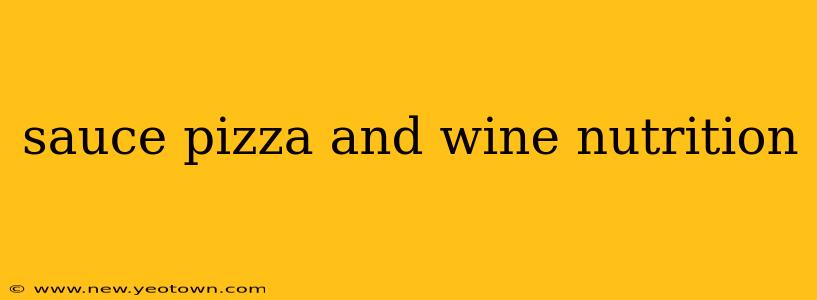Let's be honest, sometimes the best nights are spent with a perfectly sauced pizza and a glass (or two!) of wine. But amidst the deliciousness, a little voice in the back of our minds might whisper, "What about the nutrition?" This isn't about guilt; it's about mindful enjoyment. Understanding the nutritional profile of our favorite pizza and wine pairing can help us savor it even more. We'll explore the nutritional content of each component – the pizza sauce, the pizza itself, and the wine – and address some common questions along the way.
Pizza Sauce: The Foundation of Flavor
The humble pizza sauce is more than just a flavor base; it contributes significantly to the nutritional value (or lack thereof) of your entire pizza. A standard tomato-based sauce is relatively low in calories, boasting a good dose of lycopene, a powerful antioxidant linked to various health benefits. However, the nutritional content can vary dramatically depending on the ingredients. Some sauces are loaded with added sugar, sodium, and preservatives, significantly altering their nutritional profile. Opting for a homemade sauce or a high-quality, low-sodium, low-sugar store-bought version is a great way to keep things healthy.
The Pizza Itself: A Calorie Crossroads
The pizza itself is where things can get interesting – and potentially calorically dense. The crust, cheese, and toppings all contribute significantly to the overall nutritional makeup. A thin crust will generally have fewer calories than a deep-dish or stuffed crust. Cheese, while delicious, is high in saturated fat, so moderation is key. Toppings can range from the relatively healthy (vegetables) to the less so (sausage, pepperoni). Building your pizza with plenty of vegetables and lean protein sources will help you balance the nutritional equation.
What are the calories in a slice of pizza?
This is a tricky question, as it depends entirely on the type of pizza! A thin-crust margarita slice might clock in around 200-250 calories, whereas a loaded meat-lover's slice could easily surpass 400. Always check the nutritional information provided by the restaurant or pizzeria if available. Making your pizza at home gives you the ultimate control over ingredients and therefore, calorie count.
How many carbs are in a pizza?
The carbohydrate content of a pizza primarily stems from the crust and added sugars in the sauce. A typical slice can contain anywhere from 20-40 grams of carbohydrates, again depending on the crust and toppings. Choosing a whole-wheat crust can increase the fiber content, which is beneficial for digestion.
How much fat is in a slice of pizza?
Fat content in pizza is largely influenced by the cheese and meat toppings. The type of cheese used (mozzarella, provolone, etc.) also impacts the fat content. A slice could contain anywhere from 5-20 grams of fat, with saturated fat being a primary concern.
What is the protein content of pizza?
The protein content of your pizza will largely be determined by your toppings. Lean meats like chicken or turkey, or even vegetarian options like lentils or chickpeas, can boost the protein content significantly. Cheese also provides a modest amount of protein.
Wine: The Perfect Complement (In Moderation)
A glass of wine with pizza is a classic pairing, but remember that alcohol contains empty calories. Red wine, often favored with pizza, is rich in antioxidants, but it's important to drink in moderation. Excessive alcohol consumption is linked to various health problems, so savoring a glass or two is key to enjoying the experience without sacrificing your well-being.
What type of wine pairs best with pizza?
The best wine pairing for pizza depends largely on the pizza's toppings. A light-bodied red wine like Pinot Noir often complements pizzas with lighter toppings, while a bolder red like Cabernet Sauvignon might better suit richer, more savory pizzas. White wines, such as Sauvignon Blanc or Pinot Grigio, can also be excellent choices.
Does red wine have more calories than white wine?
Generally, red wines tend to have slightly more calories than white wines, but the difference is often minimal. The calorie content varies significantly depending on the type of grape, the fermentation process, and the alcohol content.
The Bottom Line: Enjoy Mindfully
Ultimately, enjoying pizza and wine is about balance. By making informed choices about ingredients, portion sizes, and mindful consumption, you can savor this classic combination without unnecessary guilt. Focus on fresh, high-quality ingredients, limit heavy toppings, choose a lighter crust, and savor your wine in moderation. The joy of the experience should always outweigh any anxieties about nutritional content!

